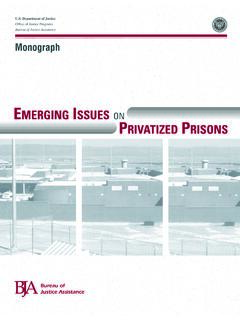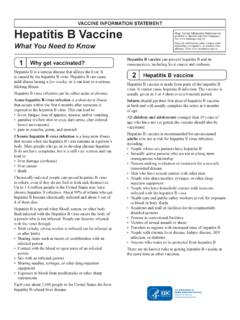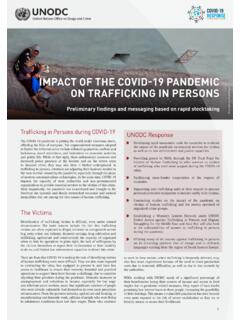Transcription of 9. Infectious diseases in prison - World Health Organization
1 739. Infectious diseases in prisonSven TodtsKey points Infectious diseases are an important problem in prisons, interacting dynamically with other problems of prisoners such as mental illness, addiction or homelessness. Contextual factors such as overcrowding, limited access to water or delays in diagnosis contribute to higher transmission rates. Every prison Health care service should have a comprehensive vaccination programme for prisoners and prison effective Infectious disease strategy is impossible without close collaboration between Health care staff and custodial staff.
2 As elsewhere in the World , prisoners in Europe have complex Health needs, which result from an amalgam of mental and physical illness, unemployment, addiction and homelessness. Infectious diseases are an important constituent of this amalgam. The different elements do not exist as separate entities but interact dynamically, as shown in the case study of the dynamics between infections and mental illness described by Rutherford (1). People with mental illness are more likely to be infected with bloodborne viruses because of risky behaviour such as homelessness, rapidly changing moods and multiple partners.
3 Brunette notes that the treatment for hepatitis with interferon can lead to depression and that people with mental illness may be less able to cope with side-effects such as fatigue (2).Incoming prisoners are at higher risk of HIV, viral hepatitis, STIs, TB and methicillin-resistant Staphylococcus aureus (3). Contextual factors inside prisons contribute to a higher risk of transmission among prisoners. Among these factors are overcrowding, delays in diagnosis and treatment, limited access to water, soap or clean laundry and lack of availability of harm reduction measures such as condoms, clean tattooing equipment or syringes (4).
4 This chapter reviews the most important Infectious diseases apart from HIV and TB, which are discussed in other since Quinton described, for the first time, an outbreak of influenza in Wandsworth prison (United Kingdom) in 1890 (5), many more outbreaks have been documented. In fact, the 1918 outbreak in the prison of San Quentin (California, United States) seems to have been one of the primary foci of the 1918 1920 pandemic (6). Nevertheless, as Awofeso (6) states, outbreaks have become rather rare in recent times.
5 Two major strategies to prevent an outbreak have been developed. The preferred strategy involves consideration of the whole prison population as a risk group and vaccination of as many prisoners as possible every year. The disadvantages of this strategy are that it is expensive (since outbreaks are rare) and that the distribution of vaccines can be complex. A recent evaluation in the United States showed that 20% of federal and state prisons and 33% of jails did not receive the necessary vaccines (7).
6 The prison population should be vaccinated for seasonal influenza every year from October to proposed strategy consists of quarantine, vaccination (if available) and short-term (prophylactic) treatment of cases and their close contacts (8). Mathematical modelling shows that this strategy might also work in a prison setting (6). If vaccination of the entire population is impossible, at least prisoners belonging to risk groups should be offered vaccination. Whichever model is chosen, it must be stressed that the model needs to take into account the equivalence of care issues (9).
7 In 2009, at a time when no vaccine was available, the H1N1 influenza epidemic also threatened the Belgian prison system. Preparations and procedures for dealing with it at national level included the following: Organization of a direct link to the national crisis coordination centre (interior affairs); creation of a crisis coordination centre for the justice department and/or prison administration; appointment of a responsible person for all information, announcements and publications; securing of funding for the prevention kits (see below: local level).
8 Setting up of a centralized registration procedure for staff members and detainees who were ill: staff returning after a bout of influenza to be placed in sections with sick prisoners; directives for separating prisoners who were not yet ill, ill or had recovered in different sections; centralized registration for the Organization of help for the hardest hit prisons;74 Prisons and Health issuing of directives for quarantine of diagnosed prisoners by the medical staff; issuing of guidelines for the use of antiviral medication and vaccines (when they became available); issuing of directives to limit movement inside facilities and into or out of affected at local level consisted of cancelling common activities and issuing prevention kits for prisons (prisoners, staff and visitors) containing: non-alcoholic hand disinfection dispensers.
9 Non-alcoholic disinfection gels in places with no access to running water; a stock of disposable mouth masks; a stock of disposable gloves and paper handkerchiefs; extra dustbins to collect all the disposable material; posters and leaflets with prevention messages (also on the intranet); a stock of dry foods (in cases where kitchens or suppliers can no longer function).Measles, mumps and rubellaMeasles is a highly contagious viral disease spread by droplet infection through sneezing and coughing.
10 Initial symptoms include high fever and a runny nose, followed by a rash descending from the head and neck. Serious complications can develop, specifically in malnourished patients or in patients with diminished immunity. Laurent et al (10) showed how the immune status of migrant populations in a Swiss prison was fairly low. Targeted vaccination programmes for migrant prisoners could reduce the risks of transmission. In fact, vaccination for measles (combined with mumps and rubella) should ideally be offered to all incoming prisoners without a reliable vaccine , mumps and rubella vaccination should also be offered to female prisoners of childbearing age without a reliable vaccine history, to protect them against authors also suggest vaccination of prisoners against varicella zoster, the virus that causes chickenpox (4).

















